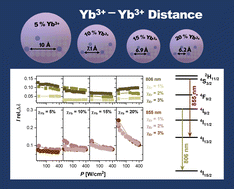Dopant ion concentration-dependent upconversion luminescence of cubic SrF2:Yb3+,Er3+ nanocrystals prepared by a fluorolytic sol–gel method†
Abstract
A fluorolytic sol–gel method was used for the fast and simple synthesis of small cubic-phase SrF2:Yb3+,Er3+ upconversion (UC) nanocrystals (UCNC) of different composition at room temperature. Systematic studies of the crystal phase and particle size of this Yb3+,Er3+-concentration series as well as excitation power density (P)-dependent UC luminescence (UCL) spectra, UCL quantum yields (ΦUCL), and UCL decay kinetics yielded maximum UCL performance for doping amounts of Yb3+ of 13.5% and Er3+ of 1.3% in the studied doping and P-range (30–400 W cm−2). Furthermore, ΦUCL were determined to be similar to popular β-NaYF4:Yb3+,Er3+. The relative spectral UCL distributions revealed that all UCNC show a strong red emission in the studied doping and P-range (30–400 W cm−2) and suggest that the UCL quenching pathway for unshelled cubic-phase SrF2:Yb3+,Er3+ UCNC differs from the commonly accepted population and depopulation pathways of β-NaYF4:Yb3+,Er3+ UCNC. In SrF2:Yb3+,Er3+ UCNC the 4S3/2 → 4I13/2 transition exhibits a notably stronger sensitivity towards P and reveals increasing values for decreasing Yb3+–Yb3+ distances while the 4I9/2 → 4I15/2 transition is significantly less affected by P and energy migration facilitated UCL quenching. These results emphasize the complexity of the UC processes and the decisive role of the crystal phase and symmetry of the host lattice on the operative UCL quenching mechanism in addition to surface effects. Moreover, the room temperature UCNC synthesis enabled a systematic investigation of the influence of the calcination temperature on the crystal phase of powder-UCNC and the associated UCL properties. Calcination studies of solid UCNC of optimized doping concentration in the temperature range of 175 °C and 800 °C showed the beneficial influence of temperature-induced healing of crystal defects on UCL and the onset of a phase separation connected with the oxygenation of the lanthanide ions at elevated temperature. This further emphasizes the sensitivity of the UC process to the crystal phase and quality of the host matrix.



 Please wait while we load your content...
Please wait while we load your content...